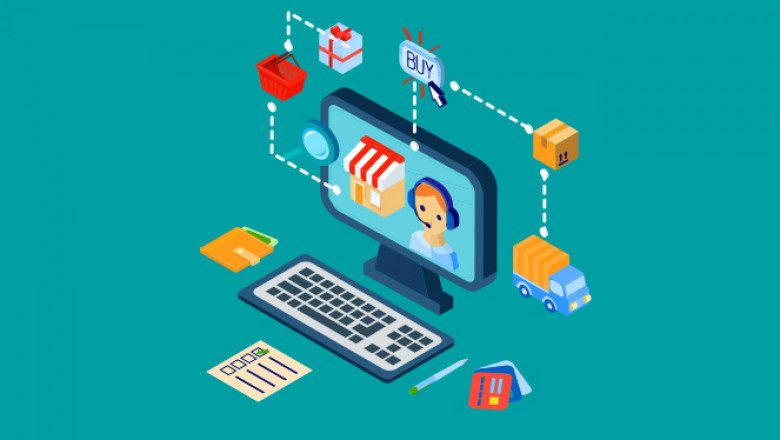views

The harsh truth is, your products and services won’t matter if you don’t have customer support and relevant strategies in place. Sales and marketing are typically the lifeblood of any retail business to reach and engage customers. It would help if you had more than this to build a reputed brand identity.
Usually, when it comes to customer services, Amazon has an excellent track record. But it keeps making mistakes. For example, in 2018, Amazon failed miserably at resolving a query of one of its regular customers. A loyal customer accidentally purchased an $88 item with a shipping cost of $7,455. Unfortunately, by the time she noticed this, it was too late. She couldn’t cancel the order, and the package was delivered. She contacted Amazon customer service, hoping to resolve the issue.
Since she was a long-time customer, she expected to have things resolved relatively quickly. But instead, she had to complain six times and write a letter to the CEO. Even then, the company told her repeatedly that they would not refund the purchase as it was delivered on time. Two and a half months later, she got her story featured on television. It was only after this that Amazon decided to reimburse the purchase.
Do you know what could have changed this scenario?
A proactive customer response!
Not only did Amazon lose a customer, but it lost a LOYAL customer and got unnecessary attention for all the wrong reasons. Loyal customers are five times more likely to make another purchase and four times more likely to refer a friend to the company. This is how vital customer service is! It is customer service that turns casual purchases into loyal customers. Well-trained support executives, responsive communication, and effective use of technology will help you build an honest customer base. But showing empathy towards your customers will set you apart!
Customer support used to be an after-thought for many retailers, but now it is establishing a solid foothold in the shopping experience. And so businesses need to think about investing in customer relationships. Only retail customer service strategies will help increase customer loyalty and carve out space in a competitive marketplace.
What is Retail Customer Service
Retail customer service refers to the assistance provided explicitly by brands to their customers who buy/use their products and services. As the industry evolves, we’ve also seen cases where communities unaffiliated with the company can also engage in the practice. In short, retail customer support is all about providing exceptional customer support to an online shopper.
It may include pre-sales as well as post-sales support, all depending on your business niche. It usually involves providing customers with assistance, answering questions, and solving their problems. However, certain factors specific to the retail industry make it essential to hone the retail customer service skills. The most crucial factor of all is the customer experience and providing proactive support.
Customer Support in 2021 and Importance of CX
The shopping patterns have drastically changed and shifted online in the last few years. Online brands are capturing the hearts and wallets of the customers. It has brought the entire ecosystem of retailers to compete on a global scale. As a result, consumer expectations are rising quickly.
Importance of Converting Casual Purchases into Loyal Customers
Many brands are taking refuge in legacy tech tools to improve their customer satisfaction rates. But customers anticipate getting a quick, personalized resolution, and that too on the channel of their choice! It is what legacy helpdesks fail to deliver. 24/7 support is no longer a perk—it is the bare minimum. So much so that 7 out of 10 consumers say they would pay more to ensure excellent customer service.
Lack of Proactive Customer Support in Retail Industry
Some common problems that retailers face:
* Keeping up with the rising tide of ticket volumes
* Leading in an environment where it is more critical to stay afloat
* Keeping up with the buying habits of customers
* Lack of agile methods and strategies
* Support reps often get frustrated with a puddle of similar queries
* Lack of advanced features in their helpdesk tools
* Lack of a standard interface to manage support
All these problems hinder retail customer service and keep retailers from providing a proactive customer experience.
Proactivity is the foundation of an exemplary customer support strategy. Communicating proactively makes the customer feel that your response is assertive and empathetic. Besides, customer experience and customer success often work in tandem to ensure customer satisfaction. Fundamentally both these aspects collate at one point: proactively reacting to customer inquiries and providing answers.
A proactive approach can help businesses take preemptive measures to track and solve problems before they occur. Retailers can anticipate future roadblocks and offer faster solutions. For example, in the above scenario, Amazon could have responded proactively. If they had looked at the complaint in an empathetic manner and not responded like automated robots, the problem wouldn’t have caught the light of the day.
Proactive customer support is one of the core tactics for growth. So, are you ready to build a solid relationship with your customers? A relationship that goes beyond live chat and emails? Here are four tips to help you improve the significant loopholes in the retail industry. Let’s get started.
Tips to Improve the Loopholes in the Retail Industry
Outperforming your competitors and setting a benchmark that no one else can outperform is the crux of this discussion. Read carefully to understand these significant loopholes, see if it applies to your industry niche (which I am sure it will), and improve accordingly.
1. Lack of Accurate Implementation of Service Level Agreements
When you look at the core problem of the above retail customer service example (about Amazon), you’ll find out that the problem could not have occurred if the SLAs had been framed accurately. The lady did put a complaint before the package was delivered. If the assigned support representative had understood the gravity of the situation and taken immediate actions, then we’d be talking about very different things today.
Your SLAs should be crystal clear and must define clear priorities. Now it can be overwhelming prioritizing things manually. For example, if you have a Twitter account and receive dozens of queries through Twitter every day, how will you define the priorities? Your agents cannot possibly go through all the tweets and filter out the most important ones.
This is where the tech part of your support kicks in. You can use automated tools to figure out which tweets to prioritize. DeskXpand allows you to go through all the tweets and convert actionable tweets into tickets so that agents can respond as soon as possible. DeskXpand uses the round-robin method of ticket allocation. It automatically fetches queries from all the channels, converts them into support tickets, and assigns them per the defined SLAs. Check out how it works.
2. Optimize Your Support Channels
Simply existing and being available on every channel won’t work in the retail business. It would help if you optimized regularly. It is not enough to offer a mobile version of your online store or build an app. True omnichannel retail customer service means understanding how customers use the various channels.
How to Optimize?
Understand the user behavior! Maybe your customer base likes to browse products through an app, shop using a desktop, search post-sales queries through the knowledge base, ask for help on chat, complain through social media, and share pictures on Instagram. Yes, it gets that layered! But once you’ve tracked this behavior, the key is in your hand. It would help to find out what channels receive the most queries and then redistribute your support resources accordingly. And the key is to have everything consolidated into a single interface.
With DeskXpand, you can streamline multiple channels such as email, feedback form, self-service, social media channels, and so on. You’ll see the difference when you can go from having to flip through browser tabs all day to answering everything on a single screen. It works like magic.
3. Generalizing Customers and Their Expectations
A single formula that fits everyone’s needs can save you a lot of time. If you apply the same logic to retail customer service, you’ll end up losing a lot of customers. Nobody wants a generic response!
Let’s understand this by analyzing a real-time retail customer service example. Here’s a screenshot of a situation that unfolded between Samsung’s service rep and a customer. As per Samsung’s policies, the customer needs to be home to sign the package when it arrives. The customer makes it clear to the support rep that they can’t afford to miss work. See how the rest of the chat unraveled.
Now, this is a plain frustration point for the customer. The service rep should’ve reached out to the manager to make an exception for this customer. All they needed to do was make a minor adjustment to the shipping schedule. Now, when a company couldn’t adjust the smallest of things, I’d surely lose interest in the brand.
Eventually, the company stuck to its policies, and it resulted in a viral Reddit thread. This brings us to our main idea that generalized customer support is a significant loophole in the retail industry.
How to Overcome This
The only solution is the personalization of services. It is a crucial element to meet customers’ needs as customers run away from generic experiences. Your support reps need to treat every customer outcome separately. You need to take care of every individual’s wants and needs. To overcome this problem, make sure:
* That your team has adequate knowledge of the customer, they’re working with.
* You have an ideal data management system in place
* Your support reps can access data easily
* That you have integrated tools to analyze and quantify your customer feedback
* Set specific KPIs for every individual customer in your CRM.
* Yes, you need to be that precise. Doing so will help you respond to your customers faster and offer personalized guidance.
4. Empathetic Response For Better Customer Experience
Customer empathy translates across industries, organizations, teams, and individuals. It doesn’t need much defining. It is a universal language that everyone can understand. It is something that speaks to the core of every company attempting to achieve it. Customer empathy isn’t about a specific strategy. You can quantify it by formula and teach your support reps.
Organizations that place customers at the center of everything and rely on human insights to inform will fundamentally empathize with their customers. Let’s take a look at the above example consideration. If the support representative had been empathetic towards the customer and had understood that they could not skip work to receive a parcel, things would have been different. Right?
How to Build Empathetic Retail Customer Service
Share your vision with your support reps about building and fostering an empathetic response. You need to ensure that every support representative sees the customer as a person and not just targets that need to be achieved. Plus, the above point about personalized services would always work.
Recommended Read: 5 Unbeaten Strategies for Building Customer-Focused Culture
The Bottomline
Fostering a great customer experience is much easier said than done. Retail customer support can be complex, but DeskXpand can help you make it easier. DeskXpand enables retailers to stand out in a busy crowd and catch (and resolve) the exact pain points of customers. Here’s your secret ammunition to making your customers feel valued. With DeskXpand, you can:
* Defined detailed service level agreements precisely as you need
* Serve personalized experience
* Analyze your customer support regularly
* Integrate your helpdesk with third-party tools and manage everything from a single interface
* Enable an empathetic response by having easy access to customer data
The Article is Originally Published On:
https://www.deskxpand.com/blog/retail-customer-service-and-four-tips-to-master-it/











